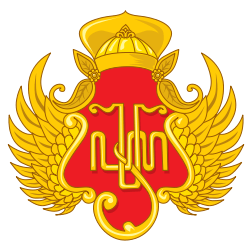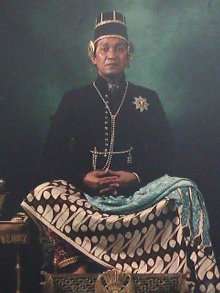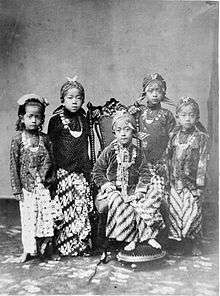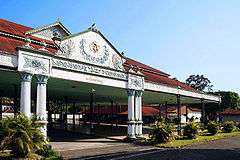Yogyakarta Sultanate
| Sultan of Yogyakarta | |
|---|---|
|
Kasultanan Ngayogyakarta Hadiningrat ꦤꦴꦒꦫꦶꦏꦴꦱꦸꦭ꧀ꦠꦤꦤ꧀ꦔꦪꦺꦴꦒꦾꦏꦂꦠꦲꦢꦶꦤꦶꦔꦿꦠ꧀ | |
 | |
| Incumbent | |
 | |
|
Hamengkubuwono X since 7 March 1989 | |
| Sultan of Yogyakarta | |
| Details | |
| Heir apparent | Princess Mangkubumi |
| First monarch | Sultan Hamengkubuwono I |
| Formation | 1755[1] |
| Residence | The Royal Palace of Yogyakarta |
| Appointer | Hereditary |
Yogyakarta Sultanate (Javanese: Kasultanan Ngayogyakarta Hadiningrat Javanese pronunciation: [ŋajogjɔkartɔ hadinɪŋrat]; Hanacaraka: ꦤꦴꦒꦫꦶꦏꦴꦱꦸꦭ꧀ꦠꦤꦤ꧀ꦔꦪꦺꦴꦒꦾꦏꦂꦠꦲꦢꦶꦤꦶꦔꦿꦠ꧀; Indonesian: Kesultanan Yogyakarta) is a Javanese monarchy in Yogyakarta Special Region, Indonesia.[2] The current head of the Sultanate is Hamengkubuwono X.[3]
| Royal family of Yogyakarta |
|---|
 |
|
His Highness The Sultan[4][5]
Extended royal family
|
History
After Sultan Agung, the Sultanate of Mataram was declining due to power struggle within the sultanate itself.[6] To make things worse, VOC (Dutch East India Company) exploited the power struggle to increase its control. At the peak of the conflict, the Mataram Sultanate was split in two based on the Treaty of Giyanti of 13 February 1755: Yogyakarta Sultanate and Surakarta Sunanate.[6][7][1]
The Giyanti Treaty mentioned Pangeran Mangkubumi as Sultan of Yogyakarta with the title of :[7]
ꦱꦩ꧀ꦥꦺꦪꦤ꧀ꦢꦭꦺꦩ꧀ꦆꦁꦏꦁꦱꦶꦤꦸꦮꦸꦤ꧀ꦏꦚ꧀ꦗꦺꦁꦱꦸꦭ꧀ꦠꦤ꧀ꦲꦩꦺꦁꦏꦸꦧꦸꦮꦺꦴꦤꦺꦴꦱꦺꦤꦺꦴꦥꦠꦶꦆꦔꦭꦒꦄꦧ꧀ꦢꦸꦭ꧀ꦫꦑ꧀ꦩꦤ꧀ꦱꦪꦶꦢꦶꦤ꧀ꦑꦭꦶꦥ꦳ꦠꦸꦭ꧀ꦭꦃꦥꦤꦠꦒꦩ
Sampeyan Dalem Ingkang Sinuwun Kanjeng Sultan Hamengkubuwono Senopati Ingalaga Abdul Rakhman Sayidin Khalifatullah Panatagama
His Highness the Sultan, Commander in the Battlefield, Servant of the Most Gracious, Cleric and Caliph that Safeguards the Religion.
During the era of Dutch occupation there were two principalities, the Yogyakarta Sultanate (Kasultanan Yogyakarta) and the smaller Pakualaman Duchy / Principality (Kadipaten Pakualaman).[7]
The Dutch Colonial Government arranged for the carrying out autonomous self-government, arranged under a political contract. When the Indonesian independence was proclaimed, the rulers, the Sultan of Yogyakarta and Prince of Pakualaman made a declaration they would become part of the Republic of Indonesia. Those two regions were unified to form the Yogyakarta Special Region and the sultan became the Governor of Yogyakarta and the Prince of Pakualaman as the vice-governor; both were responsible to the President of Indonesia.[9] The Special Region of Yogyakarta was created after the independence war ended and legalized on 3 August 1950.[7]

In carrying out the local government administration it considers three principles: decentralization, concentration and assistance. The provincial government carries out the responsibilities and authorities of the central government, while on other hand carrying out its autonomous responsibilities and authorities. The Regional Government consists of the Head of the Region and the Legislative Assembly of the Region. Such construction guarantees good co-operation between the Head of Region and the Legislative Assembly of Region to achieve a sound regional government administration. The Head of the Special Region of Yogyakarta has got responsibility as the Head of the Territory and titled as a Governor.[7]
The first Governor was the late Hamengkubuwono IX, Sultan of Yogyakarta and continued by HRH. Paku Alam VIII as acting governor until Hamengkubuwono X ascended in 1998.[10] Unlike the other heads of regions in Indonesia, the governor of the Special Region of Yogyakarta has the privilege or special status of not being bound to the period of position nor the requirements and way of appointment. However, in carrying out their duties, they have the same authority and responsibilities.[7]
Residences

The principal residence of the sultan is the kraton (palace), sometimes called the Yogyakarta Kraton but otherwise known in formal terms Kraton Ngayogyakarta Hadiningrat, Hanacaraka: ꦏꦿꦠꦺꦴꦤ꧀ꦔꦪꦺꦴꦒꦾꦏꦂꦠꦲꦢꦶꦤꦶꦔꦿꦠ꧀.
See also
- List of Sunni Muslim dynasties
- Hamengkubuwono, including list of sultans
- List of monarchs of Java
- Kraton Yogyakarta
Further reading
- Brotodiningrat, K. P. H. (1975), The Royal Palace (Karaton) of Yogyakarta: Its Architecture and Its Meaning, Yogyakarta: Karaton Museum Yogyakarta, OCLC 12847099.
- Dwiyanto, Djoko (2009), Kraton Yogyakarta: Sejarah, Nasionalisme & Teladan Perjuangan (in Indonesian), Yogyakarta: Paradigma Indonesia, ISBN 978-979-17834-0-8.
References
- 1 2 Sabdacarakatama (2009). Sejarah Keraton Yogyakarta. Penerbit Narasi. ISBN 9789791681049. Retrieved 22 February 2015.
- ↑ Surhone, Lambert M.; Timpledon, Miriam T.; Susan F., Marseken (2010). Yogyakarta Sultanate. VDM Publishing. ISBN 9786132093448.
- ↑ Kahin, Audrey (2015). Historical dictionary of Indonesia. Lanham : Rowman & Littlefield. ISBN 9780810849358.
- ↑ Indonesia Departemen Luar Negeri Direktorat (1968). Documenta diplomatica (in Indonesian). Departemen Luar Negeri. Retrieved 17 September 2018.
- 1 2 Overseas Trading. Australia: Department of Commerce and Agriculture. 1971. Retrieved 17 September 2018.
- 1 2 Ooi, Keat Gin (2004). Southeast Asia.[Volume two, H-Q]. [Volume one, A-G] : a historical encyclopedia from Angkor Wat to East Timor. Santa Barbara, Calif. : ABC-CLIO. ISBN 1576077705.
- 1 2 3 4 5 6 Sejarah Kesultanan Ngayogyakarta Hadiningrat, Tahun 1755-1950, dan Pembentukan Daerah Otonomi Khusus Yogyakarta Tahun 1950, sejarahnusantara.com
- ↑ Documenta diplomatica (in Indonesian). Departemen Luar Negeri. 1968. Retrieved 17 September 2018.
|first1=missing|last1=in Authors list (help) - ↑ Hadiwitanto, Handi (2009). Religion and generalised trust : an empirical-theological study among university students in Indonesia. Zürich : Lit. ISBN 9783643907127.
- ↑ "Yogyakarta History". Blogspot.